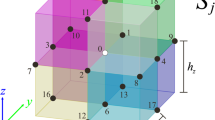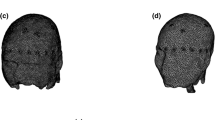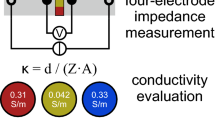Abstract
The accuracy of an electroencephalography (EEG) forward problem partially depends on the head tissue conductivities. These conductivities are anisotropic and inhomogeneous in nature. This paper investigates the effects of conductivity uncertainty and analyses its sensitivity on an EEG forward problem for a spherical and a realistic head models. We estimate the uncertain conductivities using an efficient constraint based on an optimization method and perturb it by means of the volume and directional constraints. Assigning the uncertain conductivities, we construct spherical and realistic head models by means of a stochastic finite element method for fixed dipolar sources. We also compute EEG based on the constructed head models. We use a probabilistic sensitivity analysis method to determine the sensitivity indexes. These indexes characterize the conductivities with the most or the least effects on the computed outputs. These results demonstrate that conductivity uncertainty has significant effects on EEG. These results also show that the uncertain conductivities of the scalp, the radial direction of the skull and transversal direction in the white matter are more sensible.



Similar content being viewed by others
References
Wang K, Zhu S, Mueller BA, Lim KO, Liu Z, He B (2008) A new method to derive white matter conductivity from diffusion tensor MRI. IEEE Trans Biomed Eng 55:2481–2486
Hallez H, Vanrumste B, Hese PV, D’Asseler Y, Lemahieu I, de Walle RV (2005) A finite difference method with reciprocity used to incorporate anisotropy in electroencephalogram dipole source localization. Phys Med Biol 50:3787–3806
Hallez H, Vanrumste B, Hese PV, Delputte S, Lemahieu I (2008) Dipole estimation errors due to differences in modelling anisotropic conductivities in realistic head models for EEG source analysis. Phys Med Biol 53:1877–1894
Wolters CH (2003) Influence of tissue conductivity inhomogeneity and anisotropy on EEG/MEG based source localization in the human brain. PhD dissertation, University of Leipzig, France
Wolters CH, Anwander A, Tricoche X, Weinstein D, Koch MA, MacLeod RS (2006) Influence of tissue conductivity anisotropy on EEG/MEG field and return current computation in a realistic head model: a simulation and visualization study using high-resolution finite element modelling. NeuroImage 30:813–826
Gullmar D, Haueisen J, Wiselt M, Giebler F, Flemming L, Anwander A, Thomas RK, Wolters CH, Dumpelmann M, David ST, Jurgen RR (2006) Influence of anisotropic conductivity on EEG source reconstruction: investigations in a rabbit model. IEEE Trans Biomed Eng 53(9):1841–1850
Rush S, Driscoll D (1968) Current distribution in the brain from surface electrodes. Anesth Analg 47:717–723
Sadleir RJ, Argibay A (2007) Modeling skull electric properties. Ann Biomed Eng 35:1699–1712
Oostendorp TF, Delbeke J, Stegeman DF (2000) The conductivity of the human skull: results of in vivo and in vitro measurements. IEEE Trans Biomed Eng 47:1487–1492
Law SK (1993) Thickness and resistivity variations over the upper surface of the human skull. Brain Topogr 6:99–109
Geneser SE, Kirby RM, MacLeod RS (2008) Application of stochastic finite element methods to study the sensitivity of ECG forward modeling to organ conductivity. IEEE Trans Biomed Eng 55:31–40
Si H (2004) TetGen. http://tetgen.berlios.de
Shattuck DW (2005) BrainSuite 2 Tutorial. Online version. http://brainsuite.usc.edu
Bashar MR, Li Y, Wen P (2009) EEG analysis on skull conductivity perturbations using realistic head model. Lect Notes Comput Sci 5589:208–215
Jain M, Kumaradas JC, Sharifi FJ, Whelan WM (2006) Uncertainty and sensitivity analysis for a tissue laser irradiation tissue model. In: IEEE Canadian conference on electrical and computer engineering (CCECE), pp 1171–1175
Wang Y, David RH, Kim Y (2001) An investigation of the importance of myocardial anisotropy in finite-element modeling of the heart: methodology and application to the estimation of defibrillation efficacy. IEEE Trans Biomed Eng 48(12):1377–1389
Bashar MR, Li Y, Wen P (2008) Influence of white matter inhomogeneous anisotropy on EEG forward computing. Australas Phys Eng Sci Med 31(2):122–130
Wen P (2000) Human head modelling and computation for the EEG forward problem. PhD dissertation, The Flinders University of South Australia, Australia
Glavaski S Marsden JE, Murray RM (1998) Model reduction, centering, and the Karhunen-Loeve expansion. In: IEEE proceedings of the conference on decision & control, pp 2071–2076
Wen P, Li Y (2006) EEG human head modelling based on heterogeneous tissue conductivity. Australas Phys Eng Sci Med 29:235–240
Chauveau N, Franceries X, Aubry F, Celsis P, Rigaud B (2008) Critical imaging on head template: a simulation study using resistor mesh model (RMM). Brain Topogr 21:52–60
Geddes LA, Baker LE (1967) The specific resistance of biological material—a compendium of data for the biomedical engineer and physiologist. Med Biol Eng 5:271–293
Lai Y, Drongelen WV, Ding L, Hecox KE, Towle VL, Frim DM, He B (2005) Estimation of in vivo human brain-to-skull conductivity ratio from simultaneous extra-and intra-cranial electrical potential recordings. Clin Neurophysiol 116:456–465
Baumann SB, Wozny DR, Kelly SK, Meno FM (1997) The electrical conductivity of human cerebrospinal fluid at body temperature. IEEE Trans Biomed Eng 54:220–223
Marin G, Guerin C, Baillet S, Garnero L, Meunier G (1998) Influence of skull anisotropy for the forward and inverse problem in EEG: simulation studies using FEM on realistic head models. Hum Brain Mapp 6:250–269
Li L, Wang K, Zhu S, Mueller K, Lim K, Liu Z, He B (2007) A study of white matter anisotropic conductivity on EEG forward solutions. In: IEEE proceedings of noninvasive functional source imaging of the brain and heart and the international conference on functional biomedical imaging (NFSI & ICFBI), pp 130–132
Oakley JE, O’Hagan A (2004) Probabilistic sensitivity analysis of complex models: a Bayesian approach. J R Stat Soc 63:751–769
Yan Y, Nunez PL, Hart RT (1991) Finite-element model of the human head: scalp potentials due to dipole sources. Med Biol Eng Comput 29:475–481
Baillet S, Mosher JC, Leahy RM (2004) Electromagnetic brain imaging using brainstorm. In: IEEE international symposium on biomedical engineering: macro to nano, pp 652–655
Klepfer RN, Johnson CR, Robert SM (1997) The effects of inhomogeneities and anisotropies on electrocardiographic fields: a 3-D finite-element study. IEEE Trans Biomed Eng 44(8):706–719
Author information
Authors and Affiliations
Corresponding author
Rights and permissions
About this article
Cite this article
Bashar, M.R., Li, Y. & Wen, P. Uncertainty and sensitivity analysis for anisotropic inhomogeneous head tissue conductivity in human head modelling. Australas Phys Eng Sci Med 33, 145–152 (2010). https://doi.org/10.1007/s13246-010-0015-7
Received:
Accepted:
Published:
Issue Date:
DOI: https://doi.org/10.1007/s13246-010-0015-7




